Installing a new HVAC system is a significant investment for any homeowner or business, directly influencing comfort, energy efficiency, and indoor air quality. Whether you are upgrading an old unit or starting fresh, ensuring your installation is well-planned will save you time, money, and future headaches. From proper preparation to post-installation care, here’s everything you need to keep in mind before the project begins.
Choosing the Right HVAC System for Your Space
Before installation, it’s essential to evaluate the size and design of your living or working space. An HVAC system that’s too large will cycle on and off too quickly, reducing efficiency, while an undersized system will struggle to keep up with demand. Consulting with a professional ensures that your system matches your space’s requirements perfectly. Additionally, consider features such as smart thermostats or energy-efficient components to enhance performance and reduce energy costs over time.
Ensure Proper Ductwork and Ventilation
Before installing a new HVAC unit, assess the condition of your existing ductwork. Leaks, clogs, or damaged vents can hinder airflow and cause inefficiencies. To maximize performance, it’s crucial to schedule an Air Duct Cleaning service. Clean and well-maintained ducts allow your new HVAC system to operate smoothly, improving air circulation and indoor air quality. Addressing any ventilation issues beforehand guarantees long-term efficiency and comfort.
Plan for Energy Efficiency and Safety
Modern HVAC systems come with energy-efficient features that lower utility bills while maintaining optimal performance. Look for Energy Star-rated units and systems with programmable controls. To ensure safety and efficiency, your HVAC contractor should check the insulation, wiring, and airflow pathways. In many cases, investing in Air Duct Cleaning eliminates contaminants that can hinder the system’s performance, helping you achieve a healthier, safer indoor environment.
Preparing Your Home for Installation Day
Clearing the installation area is a simple yet effective way to streamline the process. Remove furniture, décor, or obstructions that might delay the technician’s work. Inform your HVAC provider of any access points, attic spaces, or crawl areas they may need to navigate. Additionally, discussing post-installation maintenance options, such as routine inspections and filter replacements, ensures the longevity and effectiveness of your new system.
A well-executed HVAC installation goes beyond simply placing the system in your home. By prioritizing efficiency, proper ductwork, and ongoing maintenance, you set the foundation for long-term comfort and cost savings. Whether for residential or commercial use, preparing beforehand guarantees your HVAC system functions at its absolute best.
Learn More
What You Need to Know Before Installing an HVAC System in Your Home

